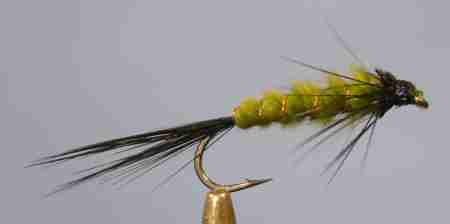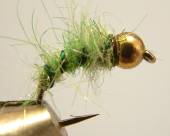Trout
now browsing by category
Posted by: Warren Prior | on October 14, 2012
Hare & Copper
Hare & Copper |
|
This fly was tied for us at the July meeting by Paul Gregg. |
|
|
|
|
Materials |
|
| Hook | 3x strong nymph #16 – 12 |
| Thread | Hyperfine black or any suitable fine thread |
| Tail | Seal guard hair |
| Body | Hares Ear and Antron dubbing mix |
| Rib | Fine Copper Wire |
| Hackle | Black or Reddish Brown |
| Weight | 6 turns Siman square lead (size dependant on weighting required) |
Tying Instructions |
|
| Wrap 6 turns of square lead around shank and position leading edge 1/2 way down shank. Select bunch of seal hair, clip and remove underfur. (Keep this for dry fly dubbing).Tie in and bind down on top of the shank to beginning of lead. Clip off excess and tie down forming a smooth transition to the lead.Tie in the copper rib on the side of the hook so that it’s leading edge is secured behind the junction of lead and shank this will ensure that the first ribbing wrap crosses over the vulnerable tail tie in spot on top of the hook. This will present a smooth uniform underbody for your dubbing.
Bind in the rib to a position between the barb and point of the hook. Lightly apply tack to the thread and touch the dubbing lightly to the thread. DO NOT OVER DUB. Now roll the dubbing tightly onto the thread and wind up to junction of shank and lead. Rib through with copper wire right to behind the eye of the hook. This will give the fly extra weight at little additional bulk. Again add tack to the thread and apply dubbing. This time do not dub tightly to the thread as you need the bulk of the thorax plus the movement. I lay a foundation of zig zag dubbing before finally running the finished layer in close turns. This gives security to the underlying dubbing and prevents it from coming off the fly adding durability. I don’t bother to pick out the thorax as the lightly dubbed hares ear is very spikey besides a few fish and it is as buggy as you will want. |
|
Posted in Fly Tying, Fresh Water Fly, Trout | No Comments »
Posted by: Warren Prior | on October 14, 2012
Coleford Limey
Coleford Limey |
|
This fly is a Peter Briggs Creation which he first tied and fished at Coleford in 1992. It proved so successful that it attained almost legendary status as a taker of trout with his angling companions. Peter in the true spirit of a fly fisherman shared the recipe and creation of this fly with us at the October 2002 meeting of the Durban Fly Tyers. |
|
|
|
|
Materials |
|
| Hook | Nymph #12 to #16 2x or 3x |
| Thread | Black |
| Tail | A small bunch of black Hackle |
| Body | Lime or Olive Green Marabou |
| Rib | Fine Copper Wire |
| Hackle | Black or Reddish Brown |
| Weight | Lead wire if Required Brass Bead if preferred |
Tying Instructions |
|
| Dress the hook with thread to a point opposite the barb. Tie in a small bunch of Black Hackle fibers and the ribbing at the same point.Strip a bunch of marabou fibers from the quill and tie in by the points, Wind the thread up to near the eye of the hook.Twist the marabou fibers into a rope an wind forward in touching turns to form the body. Stroke the fibers back between each turn. Tie off allowing space for the hackle and head. Trim excess marabou.
Bring the ribbing forward in 3-4 even turns (opposite direction to body) making sure you do not trap the marabou fibers. Tie off and trim. Tie in the hackle by the tip and wind forward in 4 even turns stroking back between turns. Tie off and trim just behind the eye. When forming the head pull the hackle fibers back and trap at the base with a few loose turns. The hackle fibers must lie back over the body. Finish the head neatly. Tie off and varnish. |
|
Posted in Fly Tying, Fresh Water Fly, Trout | No Comments »
Posted by: Warren Prior | on October 14, 2012
Elk Hair Caddis Variation
Elk Hair Caddis Variation |
|
The Elk Hair Caddis Variation is a favourite of mine both for rivers and still waters. It can be fished as an adult caddis imitation or even a small hopper at times. Size can vary from #12 for still waters mainly down to size #18 for small streams. I think the optimal sizes are #14 and #16. It floats well and can be easily seen on the water. Although it floats fairly low in the surface film, like the natural caddis it can be skated easily across the water. |
|
|
|
|
Materials |
|
| Hook | Traditional straight shank hook with wide gape |
| Thread | Black |
| Tail | Deer hair |
| Body | Peacock herl. (Experiment with other colours of dubbing.) |
| Wing | Deer Hair |
| Hackle | Grizzly or Badger |
Tying Instructions |
|
| 1) Tie in tying thread and wrap in touching turns to a point opposite the barb.
2) Tie in a short sparse bunch of deer hair as the tail. Take 2 loose turns around the shank and deer hair and then two tight turns next to this on the eye side of the hook to prevent flaring of the tail. 3) Add peacock herl o dubbing o choice to create the abdomen/thorax finishing at a point 2/3 the way back along the shank and secure. 4) Add the deer hair wing at the point you finished the abdomen, sloping it over the back with the tips finishing just short of the ends of the tail. Take two loose turns of thread around the shank and deer hair and then two tight turns next to this on the eye side of the hook to prevent flaring of the wing. Try and prevent the wing from lifting two high off the shank. Ideally it should lie across the top of the abdomen. 5) Tie in a hackle as you would for a dry fly, with fibres about width of the gape. 6) Wind the hackle forward in a few turns keeping it sparse, and secure behind the eye, leaving enough space to create a neat small head. 7) Finish the head with tying thread, whip finish and apply varnish. |
|
Posted in Fly Tying, Fresh Water Fly, Trout | No Comments »
Posted by: Warren Prior | on October 14, 2012
DDD
DDD |
|
Tom Sutcliffe is the originator of this fly which was named after Bill Duckworth who had considerable success fishing this fly in the Dargle area. Hence the name Duckworth’s Dargle Delight. |
|
|
|
|
Materials |
|
| Hook | Dry #12 to #16 2x |
| Thread | Black |
| Tail | Deer Hair |
| Body | Spun Deer Hair |
| Hackle | Ginger Cock |
Tying Instructions |
|
| Take a small clump of Deer hair and tie in a tail.Take a larger clump of Deer hair remove fluff and spin just ahead of the tail.
Repeat this step 3 to 4 times leaving enough room for the hackle and head. Remove from the vice and trim the deer hair to a cone shape. Make sure to trim very short under the hook shaft to expose the gape of the hook. Tie in the hackle by the base and wind forward in 4 even turns stroking back between turns. Tie off and trim just behind the eye. When forming the head pull the hackle fibers back and trap at the base with a few loose turns. The hackle fibers must lie back against the body. Finish the head neatly. Tie off and varnish. |
|
Posted in Fly Tying, Fresh Water Fly, Trout | No Comments »
Posted by: Warren Prior | on October 14, 2012
Bead Head Caddis
Bead Head Caddis |
|
This simple fly works well for both Yellowfish and Trout and can be effectively fished in rivers and still waters. |
|
|
|
|
Materials |
|
| Hook | Scud #12 to #16 |
| Thread | To match Dubbing |
| Rib | Green Wire (Gold or Copper) |
| Body | Life Cycle Dubbing Bright Green (Brown,Tan or Olive) |
| Eyes | Brass or Tungsten Bead |
Tying Instructions |
|
| Dress the hook with thread behind the eye until the bead sits snug. Seat with a drop of super glue.Tie in the Rib right back to 1/3 into the bend of the hook.
Form a dubbing loop at this point and spin a tapered dubbing thread. Wind forward to behind Bead forming a tapered curved body. Secure with thread and tie off. Wind the rib forward in the opposite direction and secure behind bead. Apply a tiny bit of super glue to the thread before tying off. |
|
Posted in Fly Tying, Fresh Water Fly, Trout, Yellowfish | No Comments »




 D5 Creation
D5 Creation